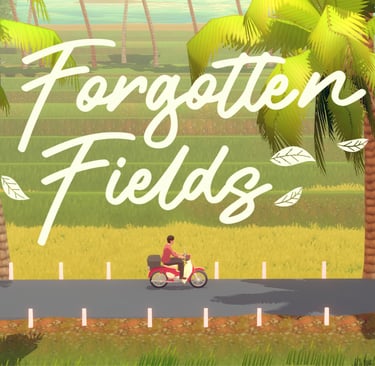Forgotten Fields – A Cozy Narrative Adventure About Nostalgia and the Passage of Time
Forgotten Fields is an intimate narrative adventure that focuses on small moments, past memories, and the creative process. Follow a young writer on his emotional journey back home, in a warm and melancholic story that resonates with anyone who has felt the passage of time and the nostalgia of what once was.
REVIEWS
Carles "Zettai"
5/29/20253 min read


Introduction
Forgotten Fields is not a traditional game but rather an intimate narrative experience that explores nostalgia and the passage of time in a warm, personal way. Developed by Frostwood Interactive (creators of Rainswept), the game follows Sid, a young writer struggling with creative block as his deadline looms. On a slow summer Sunday, Sid receives an invitation to one last family gathering at his childhood home—soon to be sold—forcing him to return to his coastal hometown in Goa, India. This everyday premise sets the stage for a slice-of-life tale full of longing and quiet reflection that many will find deeply relatable.
Story and Characters
The narrative unfolds over a single day, following Sid as he reconnects with family and old friends. Conversations touch on universal themes: youth, aging, adulthood, social media, and creativity. The tone is melancholic yet sincere, with realistic dialogue that doesn’t shy away from complex emotions.
Alongside real-world events, Forgotten Fields introduces a unique twist: glimpses into Sid’s unfinished novel. These playable fantasy sequences feature a female protagonist in surreal, dreamlike settings, contrasting with Sid’s grounded reality. They serve as windows into his imagination and creative struggles, adding depth to the narrative.
Each supporting character has a distinct backstory and personality, enriching the story with different perspectives. The game avoids dramatic twists, focusing instead on emotional conversations and subtle revelations.
Gameplay and Mechanics
At its core, Forgotten Fields is a narrative adventure prioritizing exploration and dialogue over action. You guide Sid in third person, engaging in conversations and performing simple tasks.
Gameplay is intentionally mundane—fixing small issues, chatting, or completing light puzzles. These everyday activities enhance the slice-of-life atmosphere. The fantasy sequences break up the routine with light platforming or exploration, offering contrast without complexity.
There are no penalties, timers, or fail states, making the game relaxing but also very linear. Interaction is limited; most of the experience is walking and reading, closer to a visual novel than a traditional adventure game.
Graphics and Art Design
The game adopts a warm low-poly aesthetic. Inspired by Goa, environments showcase colorful houses, golden beaches, and tropical greenery bathed in pastel tones and soft lighting, evoking the feeling of an illustrated summer diary.
That said, indie limitations are evident: basic character models, stiff animations, and a clumsy camera. Objects don’t always fade when obstructing the view, occasionally blocking perspective. While technically modest, the art direction captures nostalgia and coziness effectively.
Sound and Music
The soundtrack, composed by micAmic, is one of the highlights. Gentle piano, acoustic guitar, and occasional electronic touches set the tone, with a few licensed vocal tracks enhancing key moments.
Sound effects are subtle but immersive: waves crashing, footsteps, ambient rural noise. No voice acting is present, but a typewriter-style sound accompanies text (optional).
Switch Performance
On Nintendo Switch, performance is stable enough but comes with quirks. Expect minor bugs like floating characters, clipping, and awkward collisions, plus occasional framerate dips in open areas and long load times. While these issues don’t block progression, they do affect immersion. The game feels most enjoyable in handheld mode, though patches would help polish the experience.
The Good
Emotional, relatable narrative
Cozy slice-of-life setting with unique charm
Excellent, atmospheric soundtrack
Creative “story-within-a-story” mechanic
Light, stress-free puzzles and tasks
The Bad
Technical issues: bugs, stiff animations, clunky camera
Framerate drops and long loads on Switch
Limited, linear interactivity
Mundane tasks may bore some players
Modest visuals, unexpressive character models
Conclusion: A Nostalgic, Bittersweet Journey
Forgotten Fields shines more for what it makes you feel than for what it lets you do. Its heartfelt narrative, relaxing atmosphere, and excellent music combine into an introspective experience about memory, creativity, and family.
However, it suffers from technical shortcomings and very basic gameplay, which may deter less patient players. Recommended for those who enjoy narrative adventures that prioritize emotion over mechanics.
Final Score: 7/10
Recommended for:
Players seeking an intimate, emotional, realistic story
Fans of slice-of-life and narrative-driven experiences
Those willing to overlook technical flaws for a heartfelt tale
Available on: Nintendo Switch (reviewed), PC, PlayStation, Xbox
© 2025. All rights reserved.
And remember, if you’re into games... you’re into Sector Gaming!
